Garage heaters: sound advice on choosing the best heater
The issue of heating garages and utility rooms is relevant in the winter conditions of the northern regions. Demand creates supply, because the number of heating devices on the market is very large.
To choose the right heaters for the garage, you need to understand the principle of their action, to evaluate the cost-effectiveness, safety and the ability to solve the problem.
We have prepared an overview of the most popular solutions, outlined the pros and cons of different models, and also listed the basic rules for their operation. A step-by-step calculation of the heater power will help you choose the optimal heating device for the garage.
The content of the article:
Types of heaters and their features
The principle of operation of an ordinary heater itself is to transfer heat to the air near it. Such devices, typical for use in garages, for a long time were electric stoves, gas stoves or stove stoves. These are devices and devices of the so-called direct heating.
Now you can buy heaters that surpass these devices in efficiency, simplicity and safety of use.
Let's consider in more detail the types of heaters that can be used in a garage.
Option 1. Oil heaters
A typical representative of ordinary heaters is an electric oil cooler.

The device does not require special installation, has a very simple design, rarely breaks and you can do without special solutions to meet safety requirements.
An advantageous difference of an oil radiator compared to an ordinary electric stove is a larger heating surface area and, as a result, a significantly greater heat transfer.
Oil radiators have long been used in heating rooms for various purposes, so there is wide range of options at the time of buying. It will not be difficult to choose a device of suitable power.

First of all, for use in the garage, you must have a rheostat that controls the temperature. When the room warms up, you can turn on the radiator at full power, and to maintain the temperature - reduce to the values necessary for this.
The presence of automatic protection against overheating, as well as a sensor that fixes the slope of the device and disables it in the event of a rollover, will not interfere.
The presence of a thermostat that determines the outdoor temperature is not a priority for the garage. But equipping with a timer that allows you to turn on the device on schedule is a very convenient option if you need to warm up the garage in the morning.
Advantages of oil garage heaters:
- cheap;
- rarely breaks;
- hard to damage on impact.
A significant plus of oil-filled appliances is the safety of use in a technical room in which combustible substances are stored and used. Accidentally hitting it, you can not be afraid that the case will crack, oil will spill and the rags, paper, etc. in the garage will ignite.
Among the shortcomings of oil devices, thermal inertia dominates: the radiator must heat up itself before it begins to give off heat. The second impressive minus is the uneven heating of the room.
Option # 2. Convective heating devices
The principle of operation of convective heaters (convectors) is based on the difference in air density at different temperatures. Cold air enters the device through the lower openings, heats up, becomes lighter and exits through the upper openings.
According to this simple principle, natural air circulation occurs with its heating inside the device. The access of cold air to the heating elements increases their heat transfer, compared with standard heaters.
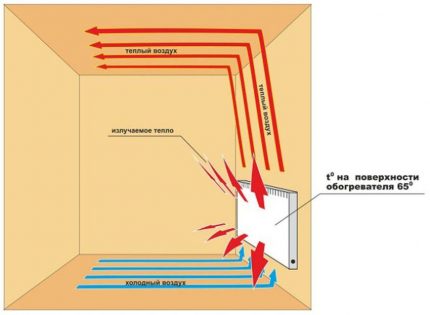
Convectors, as a rule, are mounted on walls, because it is necessary to provide space for incoming cold air from below and outgoing warm air from above. The upper holes are equipped with special guide louvers, the position of which determines the direction of movement of the outgoing warm air.
By heating principle convective heating appliances are divided into electric, gas and water varieties. Electric convectors are easier to install and operate than gas, but the power of the latter is higher.
A prerequisite for gas convective heaters is the installation of an exhaust hood for the influx of fresh air and the removal of combustion products.For small rooms, only gas convectors with a closed combustion chamber are used.
Advantages of convective garage heaters:
- the case of the device is not hot, so it is impossible to get a burn when touched;
- almost complete fire safety for electrical devices;
- lack of complex structural elements that may fail.
Convective heaters also have disadvantages. For example, an electrical device is more suitable for maintaining temperature than for quickly heating a room.
If operating in a garage, it will be necessary to regularly disassemble and clean the devices from dust.
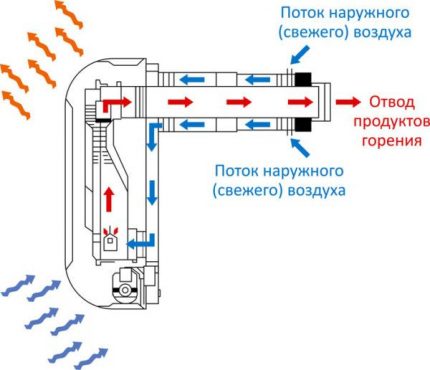
Option # 3. Electric fan heaters and heat guns
According to statistics, the proportion of fan heaters is almost half of the sales of all heating devices designed for domestic purposes.
The fan heater also operates on the principle of convective action, only the replacement of heated air with cold air is forced using the built-in device. As a rule, this is an ordinary blade fan.
At choosing a fan heater pay attention to the type of heating element. Usually use a nichrome spiral, heater or ceramic plates.
Ceramic heating elements have a lower temperature, so dust or other particles burn less and produce less burning odors.
Blade fans come in two types: axial and tangential. The tangential type of fan is less noisy and is equipped with column heaters, which are installed vertically. Their cost is more expensive than ordinary horizontal fans.
When using fan heaters for garages, the issue of the presence of a filter on the rear surface of the device is relevant. The filter must be.
It is rare that a garage is kept clean, and the intense ingress of dust inside the appliance will quickly damage the heating element and fan. It will become clogged with dust quickly enough, so cleaning the filter should be simple, and replaceable cartridges should be cheap.
Electric heat gun - This is the same fan heater, only of high power (from 3 kW). When choosing such a serious device, it is necessary to take into account the rated voltage, because powerful heat guns are designed for 380 volts.
It is also necessary to correctly assess the ability of the wiring and sockets to withstand high voltage. Quite often, they use the option of using a combination of a liquid fuel electricity generator complete with an electric gun.
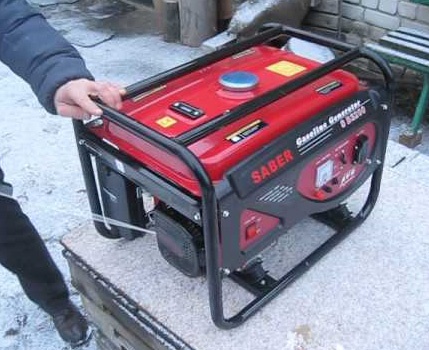
Benefits of electric garage heaters:
- are cheap;
- equally well capable of both heating and maintaining temperature;
- evenly distribute heat throughout the garage.
The disadvantage of using electric fan heaters in the arrangement of the garage is the need for effective protection against dust from entering the device. During operation, the device creates noise and stimulates the movement of air with a dust rise that is harmful to it.
Option # 4. Diesel and gas heat guns
Heaters of this type are mainly used when it is necessary to quickly heat the room. Principle of operation diesel and gas guns similar to electric, only heating occurs due to the combustion of fuel or gas.
The fan of these guns also runs on electricity, and thus access to electricity is still necessary.The diesel heat gun is the most expensive, but also the most economical installation of all other types of heating.
There are two types of guns:
- direct heatingwhen, together with a stream of warm air, combustion products enter the room, which is unacceptable for small areas;
- indirect heatingwhen the combustion chamber is isolated from the heated air and the combustion products have a separate outlet.
The gas heat gun is also economical, however, the combustion products enter the heated room. In addition, such a gun burns a lot of oxygen.
Therefore, from the standpoint of people's safety, it is very important to know what the main function of the room is: if people work in the garage, then it is better not to use a gas heater of this type.
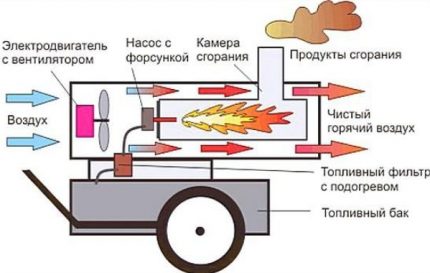
Advantages of non-electric heat guns:
- equally well capable of both heating and maintaining temperature;
- evenly distribute heat throughout the garage;
- the use of diesel fuel and gas is much cheaper than electricity.
It is worth noting the disadvantages. By analogy with other types of heat guns, diesel and gasoline equipment burns oxygen. Creates noise during work, stimulates the movement of air, which raises dust in the garage.
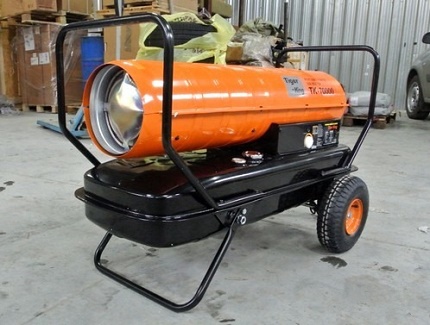
Option # 5. Infrared devices
Infrared (IR) heaters use the same operating principle as the Sun heats the Earth. Long waves of the radiation spectrum fall on objects and increase their temperature, and they already heat the air.
The designs of such devices may vary, but the main detail of infrared heaters is still the emitter.
For domestic purposes, heaters with a radiating surface temperature of up to 600 degrees Celsius are intended. In addition to electric infrared heaters, there are gas ones, however their use for poorly ventilated rooms is contraindicated.
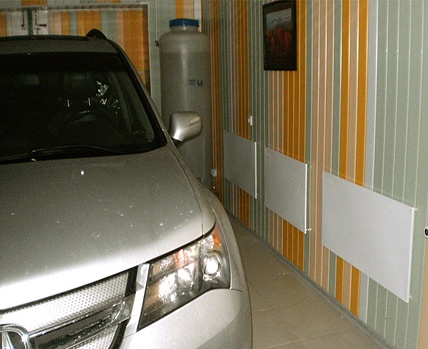
The following types of emitters are used in modern electric infrared heaters:
- Metal. Low-temperature stainless steel heater in combination with anode-coated aluminum radiating plates. The simplest and most reliable heating design. Cracking occurs when heating and cooling.
- Ceramic. A metal spiral heats a ceramic panel coated with black glaze. Not too high efficiency.
- Mycothermal. The radiating wave plate is covered with mica. Very low surface temperature of the emitting panels - only 60 degrees. Relatively high cost with the previous two options.
- Quartz. A tungsten filament is enclosed in a quartz glass vacuum tube. Like all lamps, it requires careful handling.
- Halogen. The tube contains not vacuum, but inert gas. The temperature of the filament is higher than that of a quartz heater, but there is a noticeable glow.
- Carbon. The carbon thread is enclosed in a quartz glass vacuum tube. Higher efficiency than the previous two tube heaters, but also a higher cost.
Typically, infrared heaters with emitters based on aluminum plates are used for heating garages.
Firstly, they are cheaper. Secondly, they are very reliable and work for a long time. Well, the last - they are resistant to mechanical stress (shock), which is important for the conditions of the garage.
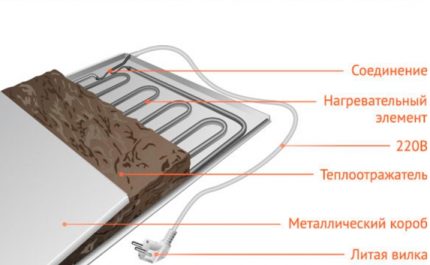
The temperature of aluminum plates during heating, as a rule, does not exceed 300 degrees Celsius, which is lower than the ignition temperature of paper and wood. Therefore, the emitter itself meets the fire safety requirements.
At these temperatures, oxygen does not burn out, so the heater can work for a long time without harm to humans.
When choosing a heater with a radiator from the plates, you need to pay attention to the thickness of the anode layer. It is desirable that it be at least 25 microns. The housing of the heater must be stainless steel, then it will not rust when used in wet rooms.
Advantages of IR garage heaters:
- by the decision of the owner, we realize uniform heating of the garage or heating of a separate area, for example, a working area in a workshop garage;
- you can heat inaccessible for other devices garage places, for example, under the hood of a car.
The disadvantage of infrared heaters for the garage is that these devices are more suitable for maintaining temperature than for quickly warming the room.
Regarding infrared heaters, there are many speculations regarding their harm to the human body.
Option # 6. Heating cables
At first glance, the idea of organizing a warm floor for a garage may seem overly luxurious, but in one case it works very well. It is about solving the problem of starting a car in extreme cold.
Can arrange electric underfloor heating only under the parking lot and turn it on in winter with severe frosts. Since a warm floor does not emit a very large amount of heat, it is necessary to limit the heating zone.
In this case, you need to throw a cover on the car so that it reaches the garage floor from all sides. Then the heating zone will be limited by the space under the machine and the machine itself.
There will be no air movement between the heating zone and the rest of the garage space, and heat loss through the cover with a temperature difference of not more than 20 degrees will be negligible.
Using this method for a car, it is possible to achieve a quite comfortable temperature environment within 10-15 degrees Celsius below zero, at a temperature in the garage minus 30-40 degrees.
The advantage of heating cables for the garage is that the power consumption of the underfloor heating is small and any wiring can withstand it.
The disadvantage of heating cables for the garage is that the work on competent laying of a warm floor quite complicated. Laying a heated floor in the garage is the most difficult job compared to installing other types of heaters.
Rules for the operation of heaters of various types
Electric heating devices are safer in their application than gas or using liquid fuel.
When operating electric heaters of any type in the garage, in addition to the basic rules for working with electrical appliances, you must pay attention to the following:
- correspondence of the possibilities of sockets and the electric network, connected to the garage, to withstand the power of the heater;
- increased humidity of the garage during the transition from negative temperatures to positive.
When operating gas, diesel and gasoline types of heaters, you must pay attention to the following:
- the possibility of gas leakage or gasoline evaporation;
- the need to take increased fire safety measures due to the presence of open fire;
- the probability of poisoning by combustion products;
- the possibility of oxygen deficiency in the garage.
Focusing on saving money on heating the garage, diesel or gasoline options should be preferred. If safety is the basis of choice, it is advisable to prefer electrical appliances.
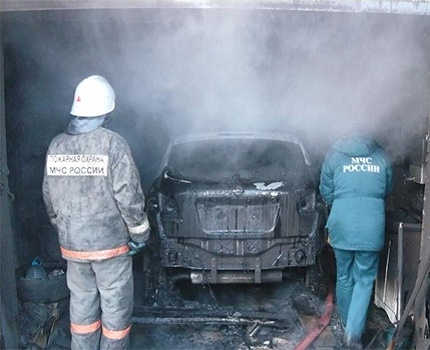
Calculation of the heat output of the heater
There is a formula for calculating the required power to maintain a constant temperature in the room:
N = V x dT x K,
Where:
- N - power (kcal / h);
- V - the volume of the room (cubic m);
- dT - temperature difference indoors and outdoors;
- K - empirical coefficient of dispersion (dispersion) of heat.
The coefficient K takes the following values:
- 0,6 – 0,9 - with high thermal insulation;
- 1,0 – 1,9 - with average thermal insulation (concrete garages with insulated doors and the absence of special ventilation);
- 2,0 – 2,9 - with low thermal insulation (concrete garages with metal doors and ventilation holes);
- 3,0 – 3,9 - without thermal insulation (metal garages).
The translation formula for kcal / h and W is as follows:
1 W = 0.86 kcal / h or 1 kcal / h = 1.163 W.
Let's solve an example. Given a standard cooperative garage shell 6 x 3 x 2 meters. Good insulation: rear, right and left - similar garages; on top of the roof 30 cm of snow; the gates are insulated with foam; hoods for the winter are plugged with foam.
At a temperature of -35 degrees, it is necessary to reach a temperature in the garage of -10 degrees and keep it for three hours for a diesel car factory. We use a fan heater as a heater.
Decision:
- V = 6 x 3 x 2 = 36 cc m;
- dT = 25 degrees;
- K = 1.5;
- N = 36 x 25 x 1.5 = 1350 kcal / h = 1570 watts.
This is the value at which the temperature in the garage will be kept within -10 degrees. To heat to this temperature, it is necessary to use twice as much power within an hour.
The answer to the problem: within one hour, the power should be 3 kW, within the next 3 hours, the power should be 1.5 kW.

Convincing landmark - prices
The price of a heater of any type of action depends on its power, functionality and manufacturer.
To compare different heaters, we take the required power from a maximum power of 2.8 kW, the presence of a rheostat for adjusting power and basic safety features relevant for using the device in the garage. For electrical models, a prerequisite is a voltage of 220 volts.
Oil heater Termica Comfort 1120 (China). Three levels of power adjustment (2900 W, 1500 W and 1000 W). Shutdown function during overheating and tipping over, frost protection. There is a small fan. Price 3 300 p.
Electric convector AEG WKL 3003S (China). Maximum power 3 kW. The presence of a thermostat, protection against overheating and overturning. Floor or wall installation. Price 5 700 r.
Gas convector Bartolini Calorama FB 4000 (Italy). Maximum power 4 kW. Closed combustion chamber, electric firing from batteries. Price 12 900 r.
Electric fan heater Comfort TPK-3000 (Russia). Two levels of power adjustment (3000 W and 1500 W). Ceramic heater, overheat protection. The price is 3 700 rubles.
Gas gun Ballu BHG-10 M (China). Maximum heating power 10 kW, power adjustment using a gearbox. Power consumption of the fan is 32 W. The price is 4 900 rubles.
Indirect diesel engine gun. Maximum heating power 25 kW, power consumption of the fan 290 watts. Thermostat with automatic shutdown support. The price is 28 500 rubles.
Infrared heater NeoClima Shaft-3.0 (Greece). Two levels of power adjustment (3000 W and 1500 W). Quartz heating element, thermostat. Wall and floor installation. The price is 3 600 rubles.
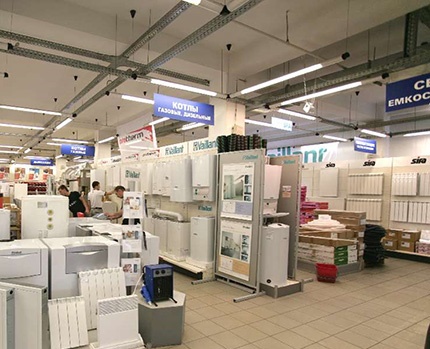
Conclusions and useful video on the topic
Option for equipping a garage with infrared heaters:
How to heat a garage with a thermal diesel gun:
There is no type or model of heater that is ideal for all garage heating applications. Depending on the conditions, various, including combined, approaches to solving this problem can be used.
A large selection of heaters available for purchase allows you to make high-quality heating for parking the car and comfortable work in the garage in almost any environment.
Looking for a garage heater? Or is there experience in using such heating devices? Please leave comments on the article and share your impressions about the use of heaters.

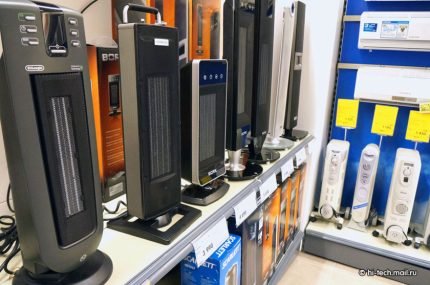
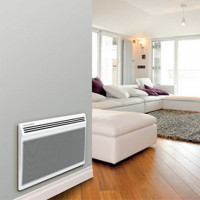 How to choose a micathermic heater: overview of types and selection tips
How to choose a micathermic heater: overview of types and selection tips 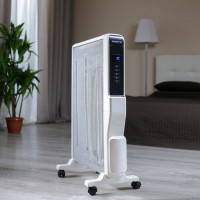 Micathermic heaters: device, principle of operation, advantages and disadvantages
Micathermic heaters: device, principle of operation, advantages and disadvantages 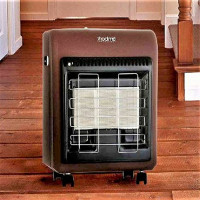 12 best bottled gas gas heaters: appliance ratings and customer tips
12 best bottled gas gas heaters: appliance ratings and customer tips  Repair of a gas heater: common breakdowns and methods for eliminating them
Repair of a gas heater: common breakdowns and methods for eliminating them 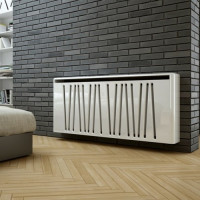 Decorative screens on the heating battery: an overview of the different types of grilles + selection tips
Decorative screens on the heating battery: an overview of the different types of grilles + selection tips 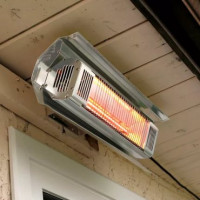 How to choose an infrared heater: classification, tips and popular models
How to choose an infrared heater: classification, tips and popular models  How much does it cost to connect gas to a private house: the price of organizing gas supply
How much does it cost to connect gas to a private house: the price of organizing gas supply  The best washing machines with dryer: model rating and customer tips
The best washing machines with dryer: model rating and customer tips  What is the color temperature of light and the nuances of choosing the temperature of the lamps to suit your needs
What is the color temperature of light and the nuances of choosing the temperature of the lamps to suit your needs  Replacement of a geyser in an apartment: replacement paperwork + basic norms and requirements
Replacement of a geyser in an apartment: replacement paperwork + basic norms and requirements
At my place, the garage is even before my birth. And naturally, there was no heating there. Last winter, there were severe frosts, and even standing in the garage, the car froze and did not start. Then I decided that it was necessary to come up with something for heating.Potbelly stoves disappeared immediately, due to their insecurity in use. I began to study and found different options. As a result, I decided to stop on a gas convector, since gas is the cheapest fuel at the moment. The project is already ready, and specialists will begin installation soon.
Of course, there are always options. The first is to sheathe the inner surface of the garage with thermal insulation and install an electric UFO heater. This is if the garage is located remotely from the house. And if the garage is located on the territory of suburban property, then the borders are expanding. You can conduct heating pipes (steam or gas heating) or install a conventional coal stove or “Potbelly stove”. My garage is in the courtyard of my house. In winter, I use the UFO electric heater: a convenient thing, it quickly warms up the garage and the air does not burn, and most importantly, there is no problem in the form of heating systems or stoves.
Most of the methods in your material are too expensive and confused. Who is this for? Apparently, people who have a large garden with a garage. For the majority of the population in our country, garages are small buildings in garage cooperatives. I'm looking for a way to heat just such a garage. And I’m not going to drown it to room temperature, the main thing is that my hands do not freeze and you can calmly shamanize the car in winter.
Why do you write that only expensive garage heating options are presented in the article? I saw both integrated solutions for years (costly) and budget options. What are the bad options for gas and electric infrared heaters? The solution is not expensive and allows you to comfortably work in the garage, even in winter.
I have a BALLU BIH-AP-2.0 IR heater, the price of the issue is 5200 rubles., I installed it on a workbench, I did the fastening myself. And so in general I have a potbelly stove in the garage, which I myself made during my vacation about two years ago. There were materials, so this decision cost me a penny. I turn on the infrared heater while the stove is melting or in the fall, when it is too early to heat the stove.